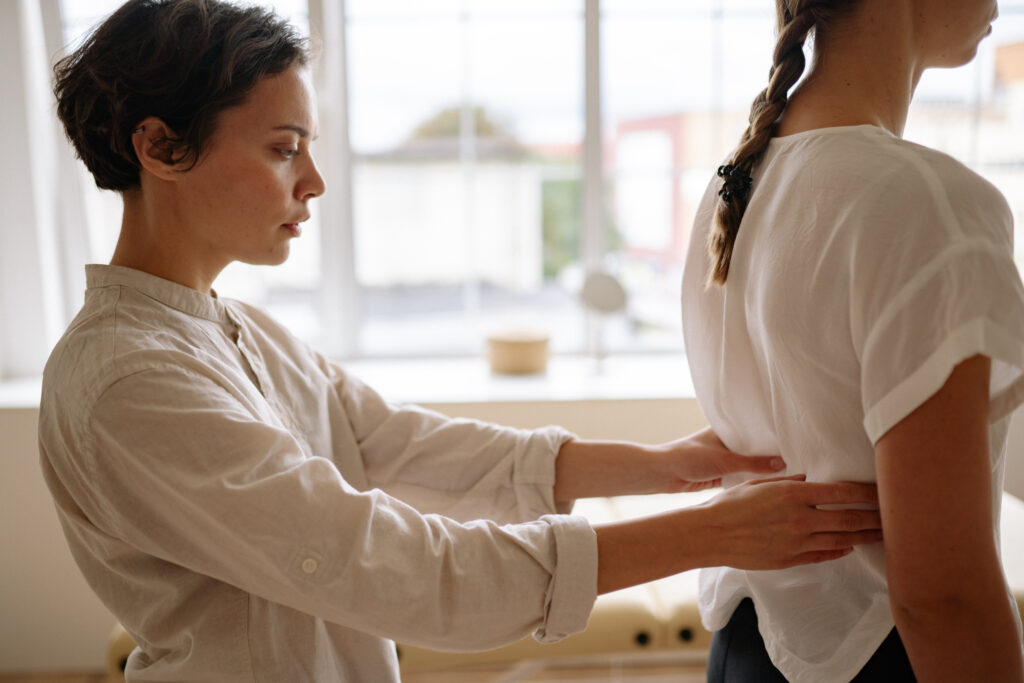
Low back pain is a common physical ailment impacting 84 percent of the world’s population. Currently, no method of treatment is considered the method of choice. Acupuncture is effective, scientific, cost-effective, and free from adverse side effects. This low back pain analysis reviews acupuncture’s role in treating back pain and includes three case studies (see original article below listed under Reference).
Western Medicine View of Low Back Pain (LBP)
Mechanical spinal disorders are the most common cause of LBP. Red flags include a history of trauma, fever, weight loss, immunosuppression, osteoporosis, long-term steroid use, and aging.
Recommended biomedical treatments include:
- Nonsteroidal anti-inflammatory drugs (NSAIDs)
- A short course of opioids
- Physical therapy
- Oral steroids
- Epidural corticosteroid injections
- Muscle relaxants
- Spinal mobilization and manipulation
Interestingly, many asymptomatic people have abnormal X-ray findings. For example, in one study involving patients aged 60+, 36 percent had disc herniations, 21 percent had spinal-canal stenosis, and more than 90 percent had degenerated or bulging intervertebral discs. These patients had no back pain despite their adverse test results.
Early Chinese Medicine Back Pain Concepts
Our low back pain analysis begins over 2000 years ago. In the Yellow Emperor’s Classic of Chinese Medicine, Huang Di, the Yellow Emperor (who reigned during the middle of the third millennium BC), discusses with his minister, Qi Bo, the treatment of LBP.
Qi Bo recommended:
- BL 40—for back pain involving the spine, neck, and hip where the patient feels they are carrying a heavy weight.
- GB 34—when the patient cannot bend, lift their head, or turn their body.
- ST 36—when the back pain makes it difficult to turn around, and the patient feels dizzy when turning.
- KI 7—for a backache involving the inner spine.
- LR 5—for back pain making the patient’s waist feel stiff like a drawn bow.
Current Chinese Medicine Back Pain Concepts
Chinese Medicine considers the lower back the dwelling place of the Kidneys. As a result, most LBP involves Kidney Deficiency. The Bladder, which has a Yin/Yang relationship to the Kidney, has its channel running along both sides of the spine. The Governor Vessel Channel travels up the center of the spine. Likewise, the Yang Heel vessel influences the area between the hip and the spine, while the Belt Vessel runs horizontally in the lower back.
The facts from this low back pain analysis are essential for selecting acupuncture points. Deficient Kidney, disrupted Qi along the Bladder Channel, injury to the muscle channels in the lower back, and attacks of Wind and Dampness (rheumatism) all contribute to the blockage of circulation of Qi and Blood in the lower back, producing LBP.
Acupoints for Low Back Pain
Recommended acupoints for addressing chronic LBP include:
- SI 3 and BL 62 to open the GV and strengthen the spine and Kidneys
- GB 41 and TB 5 to open the Belt Vessel, which runs horizontally in the low back
- BL 60, an important distal point for back pain
- KI 4 to address Kidney Deficiency
- SP 3 to invigorate the spine
- GV 20, a distal point, when the pain is on the lower part of the lumbar spine
- HT 7, a calming point, useful to harmonize the Kidney and Heart Channels
- AhShi (tender) points in the region of the sacroiliac joint (S-I joint)
Needles should be strongly stimulated, involving slow insertion and large amplitude twirling, with needle retention for 20–30 minutes following the arrival of De Qi. Needle twice weekly.
BL 40 is the Command Point for the lower back but should only be used for acute back pain. This point is not recommended to address chronic conditions. If the pain extends down the leg (sciatica), the recommended points include GB 30, BL 31, BL 37, BL 40, and BL 57. Auricular (Ear) points include: Lumbago, Adrenal, Point Zero, Shen Men, and Thalamus (select points according to tenderness.
Case Studies – Evidence for Acupuncture
Low Back Pain Analysis – Case 1
The practitioner evaluated a heavily built 29-year-old manual laborer and bodybuilder for left-sided sciatica and LBP of 1½ years duration. The pain radiated from his lower back to his left posterior thigh as far as the knee and into the groin. There were no specific aggravating factors, and the pain was constant.
An MRI showed posterior disc protrusion at the L5 and S1 levels, causing severe spinal stenosis impinging on the S-1 nerve roots, and posterior L4 and L5 disc protrusion impinging on the L5 root on the left. He obtained no relief from a series of chiropractic treatments, and his surgeon recommended a laminectomy. The patient came for acupuncture because he did not want surgery.
Case 1 Treatment
Because he had no neurologic signs and there was definite tenderness over the left S1 joint, his practitioner injected 2 mL of lidocaine into his left S1 joint region, providing temporary relief. The practitioner diagnosed him with left sacroiliac dysfunction and treated him with spinal/sacroiliac mobilization, stretching exercises, and acupuncture using the following acupoints:
- GB 41 left and TB 5 right to open the Belt Vessel
- BL 62 left and SI 3 right to open the Yang Stepping Vessel
- BL 60 bilaterally
- AhShi points over the S-I joint with strong stimulation
- GB 34 (the Influential point for soft tissues) bilaterally
- HT 7
- Deep friction over the S-1 joint.
He received treatment twice weekly for two months and then dropped to once a month. Furthermore, he was advised not to cause excessive strain on his back at work or in the gym. He continues his stretching exercises and is almost symptom-free but has a recurrence of pain whenever he strains his back at work.
Low Back Pain Analysis – Case 2
A 39-year-old man, whose work involved lifting heavy containers, was evaluated for constant LBP radiating down his left leg into the posterior thigh. An MRI showed L5/S1 disc protrusion impinging on the nerve roots. Doctors performed an L5/S1 discectomy a year ago, yet the patient’s pain continued. He also had tenderness over the left sacroiliac joint.
Local anesthetic injections to the S1 joint area provided only temporary relief. His diagnosis was left sacroiliac dysfunction. He sought out acupuncture to bring long-term relief.
Case 2 Treatment
The practitioner applied the following acupoints:
- GB 41 left and TB 5 right to open the Belt Vessel
- BL 62 left and SI 3 right to open the Yang Stepping Vessel
- BL 60 on both sides as a distal point
- AhShi points over the left sacroiliac joint
- Deep friction over the posterior sacroiliac ligament on the left side.
- Sacroiliac stretching exercises and spinal mobilization.
The acupuncturist instructed him to avoid heavy lifting. He received treatment twice weekly for six weeks with near-total relief of his symptoms. Afterward, he is to continue treatment on a monthly basis for maintenance.
Low Back Pain Analysis – Case 3
A 69-year-old housewife experienced persistent LBP radiating to the right hip for over six years. Apart from diffuse tenderness over the right back and greater trochanter of the right hip, there were no other clinical findings.
An X-ray of the lumbosacral spine showed generalized facet arthropathy. An ultrasound showed trochanteric bursitis on the right side. A local corticosteroid injection into the trochanteric bursa failed to relieve her pain. She received treatment using the same group of points as in Case 2, except for the reversal of sides used for females. Two months of twice-weekly treatments relieved most of her symptoms.
The 3 cases in this low back pain analysis demonstrate how sacroiliac dysfunction can masquerade as groin pain, sciatica, and hip pain, indicating that S1 joint dysfunction is a common cause of LBP.
Evidence for Acupuncture
In a randomized clinical trial involving 50 patients, Carlsson and Sjölund found significant decreases in LBP at 1, 3, and 6 months in the acupuncture group, compared to a placebo group. In addition, there were improvements in returns to work, quality of sleep, and analgesic intakes.
Ceccherelli et al., in a randomized controlled blind study involving 31 patients with LBP, found a considerable improvement after acupuncture, observing better results after ten weekly sessions than five weekly sessions.
Wendenberg et al., in a randomized study involving 60 pregnant women, found that acupuncture relieved pain better than physical therapy.
In addition, Kvorning et al., in a randomized study involving 73 women in late pregnancy, concluded that acupuncture relieved pelvic and LBP without adverse effects.
Molsberger et al., in a randomized, blinded, controlled trial involving 186 inpatients, demonstrated that acupuncture, when added to conservative orthopedic treatment, reduced pain, and improved mobility to a significant degree, considerably more than sham acupuncture.
More Evidence for Acupuncture
Meng et al., in a randomized controlled trial involving 55 patients over age 60, found that acupuncture reduced LBP significantly when used as an adjunctive treatment to standard therapy.
Sator-Katzenschlager et al., in a randomized double-blinded trial involving 61 patients, found continuous electrical acupuncture stimulation of auricular (ear) acupuncture points significantly reduced pain and improved psychologic well-being in patients with chronic LBP.
Yuan et al., in a review of 33 randomized clinical trials involving 6359 LBP patients, concluded, “There was moderate evidence that acupuncture was more effective than no treatment for short-term pain relief and functional improvement. In addition, there was strong evidence that acupuncture plus conventional therapy was more effective than conventional therapy alone for pain relief, and moderate evidence for reducing functional disability.”
Xiang et al., in a review involving 14 randomized clinical trials (with a total of 2110 participants) of nonspecific LBP, concluded that there were statistically significant differences in pain reduction between true and sham acupuncture but that this did not apply to function.
Still More Evidence for Acupuncture
Liu et al., in an overview of 12 systematic reviews on the effect of acupuncture on LBP, reached the following conclusions:
“Based on seven systematic reviews, acupuncture was more clinically effective for pain relief and functional improvement than no treatment, as observed in short-term follow-up. Furthermore, based on five systematic reviews, acupuncture is an effective adjunctive therapy to conventional medicine, providing short-term clinically relevant pain reduction and improving functional measures for chronic LBP.
Fox et al., in a pilot randomized clinical trial involving 30 patients with acute LBP, demonstrated that auricular acupuncture points Cingulate Gyrus, Thalamus, Omega 2, Point Zero, and Shen Men, in that order, resulted in 80% relief of pain on treatment day 1, 52% on treatment day 7, and 51% on treatment day 30.
Discussion of Acupuncture for Low Back Pain
As this low back pain analysis demonstrates, the erect human posture symbolizes our biological superiority but brings with it certain serious mechanical drawbacks, such as spondylolisthesis, disc protrusion, disc degeneration, facet arthropathy, LBP, and sciatica. LBP is not a disease but rather a group of symptoms that affect patients in all age groups. It is the most common musculoskeletal condition affecting the adult population, with a prevalence of up to 84%.
A diagnosis of chronic low back pain occurs when the condition lasts more than 12 weeks. According to a 2006 American review, the economic burden in healthcare costs and lost productivity due to LBP exceeded $100 billion annually.
In 2002, the World Health Organization anticipated that, as the world population aged, the incidence of LBP would increase substantially and become one of the leading conditions for which aging patients would require medical intervention.
Western Medical LBP Approaches
The American College of Physicians recommends non-pharmacologic treatments for LBP as the first option, including massage, acupuncture, spinal manipulation, T’ai chi, and yoga. In addition, this group concludes that treatments such as transcutaneous electrical nerve stimulation, short-wave diathermy, traction, and back support are ineffective. However, psychological therapies, such as cognitive–behavioral therapy, progressive relaxation, and mindfulness-based stress reduction, may have some value.
They recommend pharmaceutical treatments only when the above methods fail. Nonsteroidal anti-inflammatories are to be used in the lowest effective doses for the shortest-possible durations, taking into account the risks of gastrointestinal, renal, and cardiac toxicity. They do not recommend routine use of opioids because the benefits are small, the risks are substantial, and these drugs require constant monitoring.
Uncertain Therapies for LBP
Pregabalin is of doubtful value, muscle relaxants offer temporary benefits, and epidural injections provide only short-term benefits (<4 weeks). Furthermore, evidence for the benefits of radiofrequency denervation for chronic LBP is uncertain. And pain relief provided by spinal-fusion surgery is slightly more significant than nonsurgical management but comes with many adverse symptoms.
Early surgery is associated with quicker relief of symptoms for a herniated disc, compared to conservative management, but the benefits disappear over more than 1-year follow-up. The benefits of surgery and conservative medical treatment are similar for symptoms associated with lumbar spinal stenosis.
Benefits of Acupuncture
As this low back pain analysis demonstrates, the beneficial effects of acupuncture on musculoskeletal pain are well-documented. For example, in two patient-level meta-analyses of randomized clinical trials involving 18,000 and 21,000 patients with chronic musculoskeletal pain, acupuncture was substantially more effective than standard care and significantly better than sham acupuncture. In addition, in a meta-analysis of 17,922 patients with chronic nonmalignant pain, patients sustained 90% of the pain-relieving effects of acupuncture at 12 months.
Acupuncture Is Cost-Effective
Witt et al., in a randomized controlled trial plus a non-randomized cohort involving 11,630 patients, evaluated acupuncture’s clinical and economic effectiveness for chronic LBP. They determined that acupuncture and routine care resulted in a clinically relevant benefit with significant cost-effectiveness. Furthermore, Ratcliffe et al., in a randomized controlled trial involving 241 patients receiving acupuncture for LBP, found that acupuncture was cost-effective in the long term.
Acupuncture Is Safe
A cumulative review of over one million acupuncture treatments estimated that the risk of serious adverse events was 0.05 per 10,000 treatments and 0.55 per 10,000 individual patients, with similar findings in 229,230 patients with more than 2 million visits.
Acupuncture Is Based On Science
Acupuncture-point stimulation leads to the release of endorphins and other neurohumoral factors leading to changes in processing between the brain and spinal cord. In addition, acupuncture increases microcirculation and reduces inflammation by promoting the release of vascular and immunomodulatory factors.
This action results in improved joint movement, reduced muscle stiffness and decreased swelling and bruising. However, this low back pain analysis is just the beginning. Much more is still to be learned about the physiologic basis of acupuncture therapy.
SI Joint Dysfunction and Acupuncture
Sacroiliac-joint dysfunction deserves special consideration. The three illustrative cases presented in this low back pain analysis had different presentations—sciatica, hip pain, and groin pain with X-ray features supporting a disc lesion, spinal-canal stenosis, and, in the case of hip pain, trochanteric bursitis. All of these patients had years of treatment guided by the X-ray findings.
One common feature in all three cases was the presence of tenderness in the S1 joint with no X-ray evidence of an S1 joint lesion. Yet, treatment directed to the S1 joint resulted in near-total pain relief. Therefore, practitioners should look for and treat S1 joint dysfunction masquerading as pain in the hip and thigh, pain in the groin, LBP, and pain in the posterior thigh and leg.
S1 Joint Dysfunction
Many conditions can affect the S1 joint, including inflammation, degeneration trauma, infection, cancer, and sacroiliac-joint syndrome. Research indicates that 15%–20% of all LBP originates in the S1 joint. However, the incidence is much higher, as most patients turn to acupuncture after repeated failed mainstream biomedical treatments, as in the three illustrated cases.
Pain referred from the sacroiliac joint usually originates in the posterior ligaments and includes pain in the upper buttock, while dysfunctional lower sections manifest as pain in the lower buttock. Nothing in the nature of the pain distinguishes sacroiliac dysfunction from a disc protrusion compressing nerve roots. This misleading feature has led to treating many patients on the false assumption that a disc lesion was present.
Conclusions
Currently, there is no universally accepted therapy of choice for LBP. However, this low back pain analysis clearly demonstrates that acupuncture is effective, has an excellent safety record, and is cost-effective.
Next Steps
Try acupuncture if you are struggling with low back pain.
BOOK NOW to schedule an appointment online.
Watch Video About Our Back Pain Treatment.
Learn about all the conditions we treat.
Reference
Sudhakaran P. (2021). Acupuncture for Low-Back Pain. Medical acupuncture, 33(3), 219–225. https://doi.org/10.1089/acu.2020.1499
Focus Keyphrase: low back pain analysis
Photo by Yan Krukau: https://www.pexels.com/photo/physiotherapist-touching-womans-back-5793653/


What our Clients are Saying
I came to Raleigh Acupuncture. After 1 treatment, my back felt better than it has in a year. I’ve had acupuncture before elsewhere and it has never been this effective.
I went in for a bulging disc in my back and a couple of days after the first treatment I had no pain in my back. Before treatment I had a constant dull pain in the middle of my back when at rest. The treatments were about a week apart and I completed 3 of them. It has been about 3 weeks since I have been and have a slight pain in my back but is nowhere near what it was before I started treatment. Before getting acupuncture I tried chiropractic and felt worse when I was done. For those that are skeptical like me, let me tell you that it works. I would definitely recommend Dr Mark in his ability to help with your pain.
I suffered from low back pain for years and tried many different remedies. When I came to Raleigh Acupuncture, they really listened to understand my issues. I can honestly say that they cured my chronic back pain. I didn’t think it was possible, after all these years. I highly recommend this practice. The doctors take the time and do good work.


